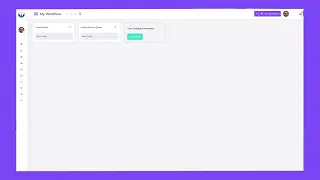In our previous post, we discussed the importance of process discovery in legal operations, focusing on how mapping out your workflows can streamline tasks, clarify roles, and enhance communication within your firm. Now, we’ll take the next step by transforming those documented workflows into a visual format, making them more accessible and easier to optimize for everyone on your team. But, you may be asking yourself, why should I start visually mapping my processes? What impact will this really have on my work?
Visual mapping is a powerful tool that builds on the process discovery work you’ve already completed. By converting your list of activities—such as initial consultations, document reviews, and trial preparations—into a visual map, you create an overview of your legal operations that is clear, intuitive, and adaptable to different learning styles.
Visual mapping is especially impactful for update meetings. We’ve heard from office managers, paralegals, and other legal professionals that having a visual way to look at case progression directly impacts how their law firm collaborates and communicates to effectively provide superior services to clients.
Why Create Visual Maps of Your Processes?
Visual mapping is more than just diagramming; it’s about making your workflows universally accessible and easier to manage. Here’s why visual mapping is so effective:
-
- Cater to Diverse Learning Styles: People absorb and process information differently. Visual mapping caters to various learning styles, making complex processes easier to understand for everyone, whether they prefer visual aids, step-by-step guides, or holistic overviews.
- Leverage Popular Visual Tools: Visual representations of information, such as infographics, have become incredibly popular because they simplify complex data and processes into digestible formats. By using visual mapping in your legal operations, you tap into this trend, making your workflows not only functional but also engaging and easier to comprehend.
- Identify Redundancies and Bottlenecks: A visual workflow helps you quickly pinpoint areas where tasks are duplicated or where bottlenecks occur, allowing you to address inefficiencies more effectively.
- Enhance Team Collaboration and Transparency: Team members can more easily understand their roles and responsibilities when workflows are visually mapped, leading to better collaboration and fewer misunderstandings.
How Does Visual Mapping Work in Legalboards?
Legalboards is designed to make the transition from written process discovery to visual mapping as seamless as possible. Here’s how you can use Legalboards to bring your processes to life:
-
- Drag-and-Drop Interface: With Legalboards, you can easily translate the steps from your process discovery—such as initial consultations, document reviews, and trial preparations—into a visual workflow using a simple drag-and-drop interface. You can even take that a step further and drag-and-drop cards between columns to reflect the case progression.
- Customizable Workflows: Every firm has its unique needs. Legalboards allows you to customize each step of the workflow to fit the specific requirements of your team, ensuring that your visual maps are both accurate and practical. To give you an idea of this, you can customize your column colours, give custom labels to cards, and choose the board or task view depending on your needs.
- Real-Time Updates: As your cases progress, Legalboards ensures that your visual workflows are always up-to-date, providing real-time visibility into every aspect of your operations. We integrate with other leading legal technology, so you can reduce your need for dual data entry, keep everything you need in one place, and more.
- Task Assignment and Monitoring: By visually mapping your workflows, you can assign tasks to specific team members directly within the platform, making it easier to track progress and ensure accountability.
Example: Litigation Board
Legalboards uses the Kanban framework, a prominent agile methodology, to organize matters, contacts, and tasks. Consider the same example from our first post, a litigation board. You know that while some matters are more complex, most follow the same general process.
As shown below, you can take the general steps and translate them into different columns that organize your workflow. If you need more help taking your current workflows into visual maps or digitalizing that, contact us at support@legalboards.com.
Our Business Litigation Board is designed to provide clear, step-by-step visibility into each phase of a case. The board is divided into columns, each representing a key stage, from ‘Intake’ to ‘Post-Trial.’ This structure allows teams to easily track the progression of tasks and ensures a smooth workflow. Let’s walk through a few examples using our litigation board.
Real Automation Examples:
Intake/Initial Consultation
Automation: When a new case card enters the ‘Intake’ column, Legalboards can automatically create and assign tasks like ‘Schedule Initial Meeting,’ ‘Send Client Agreement,’ and ‘Request Basic Documents’ to the responsible team member.
Why this matters: Automates the first steps, ensuring nothing is missed right at the start and speeding up case onboarding.
Document Gathering
Automation: If a task like ‘Collect Financial Statements’ or ‘Request Signed Affidavit’ isn’t completed within 5 days, an automated reminder email is sent to the client, and the team gets a notification.
Why this matters: Ensures proactive follow-up without manual reminders, keeping the document collection phase on schedule.
Trial Prep
Automation: When a card moves to ‘Trial Prep,’ Legalboards can generate a checklist that includes tasks like ‘Finalize Witness Statements,’ ‘Organize Exhibit Binder,’ and ‘Prepare Opening Arguments.’ Each task is auto-assigned to relevant team members.
Why this matters: Ensures systematic preparation by breaking down the complex trial prep phase into manageable, clear tasks, reducing the risk of oversight.
These automations take routine tasks off your plate, keep the workflow moving, and ensure that your team can focus on strategic, high-value activities.
Automating Your Legal Operations
Automation is what really takes your visual mapping to the next level. Automating routine tasks can significantly enhance your firm’s efficiency, allowing your team to focus on more critical, high-value activities.
Steps to Start Automating with Legalboards
As a refresher, you can check out this guide to the basics of automation within Legalboards. But, it’s important to think of automation as an “if this, then that” recipe as you get started. This process will help you identify what needs to be automated and how:
- Identify Repetitive Tasks:
Review your visual workflows to pinpoint repetitive tasks that can be automated, such as sending reminders, scheduling meetings, or updating case statuses. - Set Up Triggers and Actions:
Legalboards lets you create automated triggers based on your visual workflows. For instance, once a document is reviewed, the system can automatically notify the next person in line or update the client’s case status. For detailed guides on specific triggers and actions, check out our guides on automation. - Integrate with Other Tools:
Legalboards can integrate with your existing tools, ensuring that your automation process is smooth and that data flows seamlessly across your platforms. You can find the full list here. - Monitor and Adjust:
Automation is not a set-it-and-forget-it solution. Use the reporting features in Legalboards to regularly monitor the effectiveness of your automations and make necessary adjustments for optimal results.
Conclusion
As you can see, visual mapping and automation are powerful extensions of the process discovery work we’ve covered previously. By bringing your workflows into a visual format and then automating repetitive tasks, you can significantly boost your firm’s efficiency and client satisfaction.
If you’re ready to take the next step in optimizing your legal processes, contact us today to learn how Legalboards can help you streamline and automate your legal operations.








